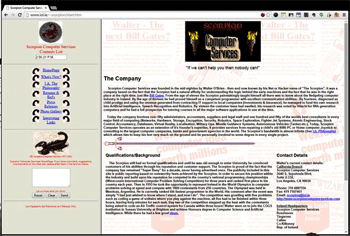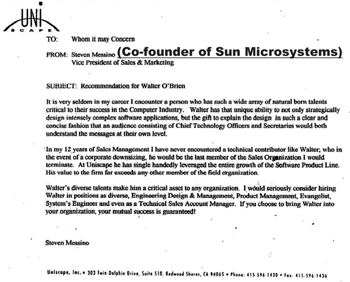from the give-it-up-shiva dept
by Mike Masnick
Tue, Mar 8th 2016 11:40am
NOTICE: THIS WORK MAY BE PROTECTED BY COPYRIGHT
YOU ARE REQUIRED TO READ THE COPYRIGHT NOTICE AT THIS LINK BEFORE YOU READ THE FOLLOWING WORK, THAT IS AVAILABLE SOLELY FOR PRIVATE STUDY, SCHOLARSHIP OR RESEARCH PURSUANT TO 17 U.S.C. SECTION 107 AND 108. IN THE EVENT THAT THE LIBRARY DETERMINES THAT UNLAWFUL COPYING OF THIS WORK HAS OCCURRED, THE LIBRARY HAS THE RIGHT TO BLOCK THE I.P. ADDRESS AT WHICH THE UNLAWFUL COPYING APPEARED TO HAVE OCCURRED. THANK YOU FOR RESPECTING THE RIGHTS OF COPYRIGHT OWNERS.
Over the years, we've written a few times about Shiva Ayyadurai, a guy who's basically staked his entire life on the misleading to false claim that he "invented" email. Every couple of years he pops up again as he's able to fool some reporters into believing him. In 2012, he fooled the Washington Post and, astoundingly, the Smithsonian. In 2014, he was somehow able to get the Huffington Post to publish a multi-part series claiming he had "invented" email -- though after we called them out on it (and after they stood by it) -- those stories were eventually deleted. Ayyadurai also threatened to sue us for calling out his false claims, but there's been no lawsuit yet.
In those previous stories, we've explained why his claims are false in fairly great detail. Here's the quick version:
First off, no one denies that V.A. Shiva Ayyadurai -- an apparently very bright 14-year-old at the time -- wrote an email software program for the University of Medicine and Dentistry of New Jersey (UMDNJ) in 1978. By all accounts, it was a perfectly decent email system that allowed the UMDNJ staff to send electronic messages. Further, no one doubts that, in 1981, Ayyadurai registered the copyright on his program, which was called EMAIL. The problems are that (1) email was invented long before 1978, (2) the copyright is merely on the specific software code, not the idea of email, and (3) while Ayyadurai may have independently recreated the basics of email (and even added a nice feature), none of his work was even remotely related to what later became the standards of email. What's most sickening about this is that as part of this new PR campaign, Ayyadurai is ridiculously arguing that the reason no one believes him isn't because he's simply wrong, but because they can't stand to believe that "a dark-skinned immigrant kid, 14 years old," invented email, and that it was done in "one of the poorest cities in the US" rather than at a famous university.
Again, that might make for a nice story line if there were some factual basis behind it, but there isn't. The history of email is well-documented from multiple sources and it began way, way before 1978. And while early versions were somewhat crude, by 1978 they had basically everything that Ayyadurai claims to have invented (it is entirely believable that Ayyadurai, as a bright kid, independently came up with the same ideas, but he was hardly the first). There was a messaging system called MAILBOX at MIT in 1965. You can read all the details of it here, including source code. Ray Tomlinson is frequently credited with inventing the modern concept of email for the internet by establishing the @ symbol (in 1972) as a way of determining both the user and which computer to send the email to. By 1975, there were things like email folders (invented by Larry Roberts) and some other basic email apps. As is noted, by 1976 -- two years before Ayyadurai wrote his app -- email was 75% of all ARPANET traffic.
There's also the fact that even if Ayyadurai had done something different at that dental school (and there's no evidence he really did), that had no impact at all on the growth and success of email. No one else built out email systems because of what they saw Ayyadurai build. Email came and grew out of all of that other work (most of which pre-dated Ayyadurai). Hell, just look at RFC 733 from 1977 (before Ayyadurai started working at the school), which basically lays out all of the features of email.
MYTH #4: RFCS DEMONSTRATE "EMAIL" EXISTED PRIOR TO 1978
Requests for Comments (RFCs) were simply written documentations, not an email computer program, nor an email system. RFCs were literally meeting notes that recorded the meetings of electronic messaging researchers in the 1970s. As such, this is a flagrant misuse of the term “email”.
For example, sensationalist statements, such as the one by issued by Gizmodo in 2012 stating:“[E]mail underpinnings were further cemented in 1977's RFC 733, a foundational document of what became the internet itself.”
are, at best misinformed, and completely lack understanding that email was the electronic interoffice mail system. Furthermore, email does not need the Internet to operate. Email systems initially ran on Wide Area Networks (WANs) and Local Area Networks (LANs), independent of the Internet and ARPANET. In fact, even today, one doesn’t need the Internet to run email.
Moreover, RFC 733 was a document to define an attempted standard that was never even fully accepted. The very term “RFC” means “Request for Comments”. It was a document created from meeting notes, and proposed ideas for message format and transmission, but said little about feature sets of individual electronic messaging or mail systems.
As the opening of RFC 733, it states:“This specification is intended strictly as a definition of what is to be passed between hosts on the ARPANET. It is not intended to dictate either features which systems on the Network are expected to support, or user interfaces to message creating or reading programs.”— http://tools.ietf.org/rfc/rfc733.txt
Therefore, RFCs do not demonstrate that email existed prior to 1978. What RFCs demonstrate are that meetings and discussions were taking place on defining methods to exchange text messages, not the creation of email.
-- The Five Myths About Email’s History, by Deborah J. Nightingale, Ph.D.
Despite all of this, Ayyadurai refuses to give up his claims. Part of the way he's tried to get around this is to redefine email to include an increasingly long list of features, most of which are not at all necessary for email. The list changes over time and grows -- basically every time someone points out that all of the things he had on earlier lists were found in programs pre-dating Ayyadurai's own program. Ayyadurai also totally misrepresents what a copyright is, and insists that his copyright is just like a patent, because you couldn't patent software back then. That's basically not true. It is true that most software was not considered patentable back then (even though some was), but that still doesn't make the copyright the equivalent of a patent.
Throughout all of this, Ayyadurai and the weird collection of supporters he's built up -- bizarrely including Noam Chomsky and PR guru Larry Weber -- seemed to keep targeting Ray Tomlinson as some sort of evil mastermind behind the racist plot to take down Ayyadurai, because Tomlinson worked for Raytheon, and Weber, Chomsky and Ayyadurai could spin this bizarre and totally made up story of a big American defense contractor wanting to rewrite history to write out someone with "brown skin."
Tomlinson, as you probably have heard already, passed away this weekend, and received tremendous praise across the internet. Many referred to him as the "inventor of email" even though Tomlinson himself had long insisted that was not true either. Instead, he (unlike Ayyaudurai) long admitted that the growth and success of email involved many people working in pieces, building on each other's work successfully to build out the tool that we all use today. Still, Tomlinson actually does deserve tremendous credit for making email what it is today. The most notable claim -- and the one that everyone rightly talks about -- is his decision to make use of the @ symbol as a part of email addresses, in order to send email messages across networked computers, rather than just on a single machine (as had been done previously).
But, much more importantly, Tomlinson was actively engaged in setting the standards for email, such as in RFC 561 in 1973 (five years before Ayyadurai did anything), in which he and others laid out the standards for email headers.
Given all this, you'd hope that Ayyadurai could let Tomlinson's passing go in peace, and let people celebrate all of the work he did to actually bring email to the world. But, nope. That's not what's happening. Instead, Ayyadurai has gone on a Twitter rampage, tweeting at basically every journalist who has written about Tomlinson, and calling them liars. This is only a small snippet of about 3 hours worth of his tweets.

Most of those are pointing to his "correction" posted to his website, claiming that anyone claiming Tomlinson invented email is wrong. He repeats the false claims about how it only qualifies as email based on his totally arbitrary list of features and also that people who say he's wrong are simply backing up Raytheon trying to deny him his rightful due because he's "not white." And, amazingly, he's actually convinced some publications to write about his claim, with very little fact checking. Meanwhile, when some point out that he's lying, Ayyadurai yells at them that they're repeating "racist lies," despite the fact that all of the evidence is well-documented.
Once again, to Shiva Ayyadurai: you were almost certainly a very bright kid, who created a nice software program as a teenager at the school where you were employed. That's great. And you should be proud of your accomplishments. But you did not invent email. You had nothing to do with the invention of email. And to continue to claim otherwise makes you look petty and silly -- especially at a time when everyone is celebrating the very real accomplishment of Ray Tomlinson.





